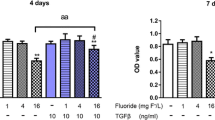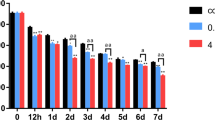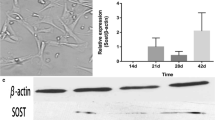Abstract
Chronic excessive fluoride intake may cause fluorosis, which chiefly manifests as bone damage (or skeletal fluorosis). However, the molecular mechanism of skeletal fluorosis has not been clarified up to the present. The objective of this study was to analyze the effects of fluoride treatment on two of bone morphogenetic protein family member (BMP-2 and BMP-3) expression and cell viability using human osteosarcoma MG-63 cells as a model. Sodium fluoride (NaF) had pro-proliferation effects at relatively moderate concentration, with 5 × 103 μmol/L having the best effects. At 2 × 104 μmol/L, NaF inhibits cell proliferation. BMP-2 and BMP-3 expression was significantly induced by 5 × 103 μmol/L NaF and, to lesser extent, by 2 × 104 μmol/L NaF. Correspondingly, mothers against decapentaplegic homolog 1 (Smad-1) increased at both doses of NaF, which indicated the BMP signaling pathway was activated. Notable increases in secreted alkaline phosphatase (ALP) were observed when cells were treated with 5 × 103 μmol/L NaF. A BMP specific inhibitor LDN193189 suppressed cell proliferation induced by 5 × 103 μmol/L NaF. Also, 2 × 104 μmol/L NaF induced apoptosis but likely through a mechanism unrelated to the BMP pathway. Collectively, data show that NaF had dose-dependent effects on cell proliferation as well as BMP-2 and BMP-3 expression in MG-63 cells and suggested that cell proliferation enhanced by NaF-induced BMP members may be a molecular mechanism underlying skeletal fluorosis.





Similar content being viewed by others
References
Agalakova NI, Gusev GP (2012) Molecular mechanisms of cytotoxicity and apoptosis induced by inorganic fluoride. ISRN Cell Biology 2012:1–16
Heller KE, Eklund SA, Burt BA (1997) Dental caries and dental fluorosis at varying water fluoride concentrations. J Public Health Dent 57:136–43
Chachra D, Turner CH, Dunipace AJ et al (1999) The effect of fluoride treatment on bone mineral in rabbits. Calcif Tissue Int 64:345–51
Fejerskov O, Manji F, Baelum V (1990) The nature and mechanisms of dental fluorosis in man. J Dent Res 69:692–700
Grynpas MD (1990) Fluoride effects on bone crystals. J Bone Miner Res 5:169–75
Mousny M, Omelon S, Wise L et al (2008) Fluoride effects on bone formation and mineralization are influenced by genetics. Bone 43:1067–1074
Organization WH (2006) Country data on dental and skeletal fluorosis associated with exposure to fluoride through drinking-water. In: Fawell J (ed) Fluoride in drinking-water. IWA Publishing, London, pp 97–125
Sun D, Sun Y (2005) Report on epidemiology investigation of endemic fluorosis in China. Chin J Epidemiol 20:81–84
Christie DP (1980) The spectrum of radiographic bone changes in children with fluorosis. Radiology 136:85–90
Wang W, Kong L, Zhao H et al (2007) Thoracic ossification of ligamentum flavum caused by skeletal fluorosis. Eur Spine J 16:1119–28
Massague J (1998) TGF-beta signal transduction. Annu Rev Biochem 67:753–791
REDDI AH, HUGGINS C (1972) Biochemical sequences in the transformation of normal fibroblasts in adolescent rats. Proc Natl Acad Sci 69:1601–5
Reddi AH (1981) Cell biology and biochemistry of endochondral bone development. Coll Relat Res 1:209–26
Sandrine P, Lee N (2000) BMPs are required at two steps of limp chondrogenesis: formation of prechondrogenic condensations and their differentiation into chondrocytes. Dev Biol 219:237–49
Macicas D, Ganan Y, Sampath TK et al (1997) Role of BMP-2 and OP-1 (BMP-7) in programmed cell death and skeletogenesis during chick limb development. Development 124:1109–17
Wei Y, Zhang Z, Long JF et al (2013) Expression of bone morphogenetic protein in coal-burning fluorosis rats. Chin J Epidemiol 32:374–377
Yu PB, Deng DY, Lai CS et al (2008) BMP type I receptor inhibition reduces heterotopic ossification. Nat Med 14:1363–9
Farley JR, Wergedal JE, Baylink DJ (1983) Fluoride directly stimulates proliferation and alkaline phosphatase activity of bone-forming cells. Science 222:330–2
Yan X, Feng C, Chen Q et al (2009) Effects of sodium fluoride treatment in vitro on cell proliferation, apoptosis and caspase-3 and caspase-9 mRNA expression by neonatal rat osteoblasts. Arch Toxicol 83:451–8
Yan X, YAN X, Morrison A et al (2011) Fluoride induces apoptosis and alters collagen I expression in rat osteoblasts. Toxicol Lett 3:133–8
Long L, Li L, Liu K et al (2004) Study on effect of sodium fluoride on osteoblast-like cell in vitro. China Prev Med 5:168–71
Cai R, Guo X, Zhao X et al (2009) Effects of fluoride and aluminum alone and combination exposure on proliferation and cell cycle of MC3T3-E1 cells. J Environ Health 26:1089–91
Chen D, Ji X, Harris MA et al (1998) Differential roles for bone morphogenetic protein (BMP) receptor type IB and IA in differentiation and specification of mesenchymal precursor cells to osteoblast and adipocyte lineages. J Cell Biol 142:295–305
Ryoo HM, Lee MH, Kim YJ (2006) Critical molecular switches involved in BMP-2-induced osteogenic differentiation of mesenchymal cells. Gene 366:51–7
Kawabata M, Imamura T, Miyazono K (1998) Signal transduction by bone morphogenetic proteins. Cytokine Growth Factor Rev 9:49–61
Xu S, Zheng G, Li M, Shu B (2000) Direct effects of fluoride on activities of bone morphogenetic protein. Zhonghua Yu Fang Yi Xue Za Zhi 34:215–7
Acknowledgments
This study was supported by the National Natural Science Foundation of China (81360412) and Science and Technology Funds from the Department of Science and Technology of Guizhou Province (No. SY [2013] 3062 and J [2010] 2268).
Conflict of Interest
No conflict of interest exits in the submission of this manuscript, and manuscript is approved by all authors for publication. The work described was original research that has not been published previously and not under consideration for publication elsewhere. The opinions expressed by the authors contributing to this journal do not necessarily reflect the opinions of the Guiyang Medical University with which the authors are affiliated.
Author information
Authors and Affiliations
Corresponding author
Additional information
Biographical Sketch
Yan Wei, Associate Professor of Guiyang Medical University.
Rights and permissions
About this article
Cite this article
Wei, Y., Wu, Y., Zeng, B. et al. Effects of Sodium Fluoride Treatment In Vitro on Cell Proliferation, BMP-2 and BMP-3 Expression in Human Osteosarcoma MG-63 Cells. Biol Trace Elem Res 162, 18–25 (2014). https://doi.org/10.1007/s12011-014-0148-8
Received:
Accepted:
Published:
Issue Date:
DOI: https://doi.org/10.1007/s12011-014-0148-8




